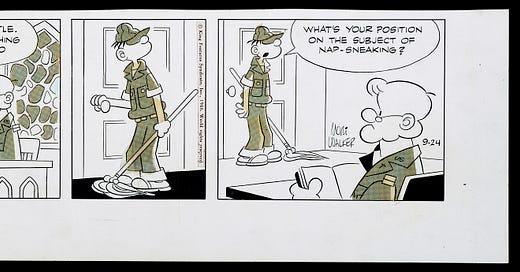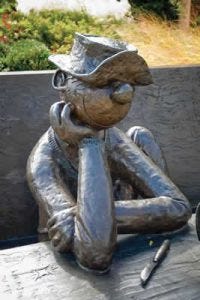America's Omnipresent Soldier: Beetle Bailey
The Literature of Army Writers and America's Sense of Self. Part VIII: Mort Walker Mort Walker
Source: National Museum of American History.
The comic book stand was my first library. Day after day, I sat in my grandparent’s neighborhood grocery store, reading every comic I could: Marvel, DC, Archie, if they had it, I read it. And every Sunday, I poured through the comics section of the weekly paper my parents brought home after church. I did not know it at the time, but my childhood, the late 80’s and early 90’s, was a golden era in cartoon and comic strips, with artists like Bill Watterson and his “Calvin and Hobbes” leading the way. Yet amid all this, one comic strip stood out: “Beetle Bailey”.
Beetle Bailey was one of the only comics with a soldier as its main character and an Army base its primary setting.1 As someone not from a military family—my grandfather had served in the Navy in World War II, but like many of his generation, did not regularly talk about his experience—Beetle Bailey was my primary portal to the military.
Despite my unfamiliarity with the Army, Beetle Bailey was eminently relatable. The stories took readers into the military, but through plot lines more about goofy, irritating, and sometimes poignant human behavior than anything particular to uniformed life. Beetle Bailey could easily have been set in an office, hospital, studio, or any other organizational space; in fact, the first season of the comic put Beetle Bailey in college.
The setting still mattered, however. I was far from the only kid in America whose main interaction with the Army came via my weekly comic reading. The interplay between Beetle Bailey and his crew—Sgt. Snorkel, Gen. Halftrack, Lt. Flap, Miss Buxley, Private Blips, and many others—allowed me, and millions of other Americans, to take in the iconography and vocabulary of the military. For 68 years as a daily comic, Beetle Bailey served as one of the most frequently trafficked bridges between civilian America and the military. It continues to do so today.
We can thank its creator, primary author, and Army veteran Mort Walker, for this unique contribution to American art and civil-military relations. Mort was drafted in 1943 and trained at Camp Chowder in Missouri.2 It rained with such frequency and intensity that soldiers gave the base the name, “Camp Swampy”, which went on to become Beetle Bailey’s home in the comic strip. Following training, Mort served in Italy as an intelligence officer during World War II and was discharged after two years.
Statue of Beetle Bailey on the University of Missouri campus. Source: City of Columbia.
After attending the University of Missouri, Mort started cartooning. In 1950, he launched Beetle Bailey, with our protagonist set as a college student. After about a year of less-than-stellar sales, however, Mort had Bailey enlist and move to Camp Swampy. Sporting Army greens, Bailey found an audience.
Beetle Bailey was syndicated by King Features, a division of Hearst—it was reportedly the last comic strip approved directly by William Randolph Hearst. Readership expanded over the decades and new characters joined Camp Swampy. By the late twentieth century Beetle Bailey was a global phenomenon, reaching over 200 million readers everyday.
Over that time period, Mort launched several other comic strips, including “Hi and Lois” and “Sam & Silo”. He also focused considerable energies towards preserving cartoons and advocating for them to be taken seriously as art. He started the National Cartoon Museum in the 1970s and grew his own collection of comics to over 200,000 selections. In the early 2000s, he merged his collection with that of Ohio State University (OSU). OSU continues to be there home, with the comics available to the public at the Billy Ireland Cartoon Library & Museum.
Beetle Bailey turns 75 this year. Mort passed away in 2018. Over the years Mort and Beetle Bailey received numerous accolades from the Army, including the Army’s highest award for civilians, the Distinguished Civilian Service Award.
Laughter is a serious matter. A comic strip like Beetle Bailey helps the Army feel just a little more familiar to most Americans. The type of humor Mort directed towards the Army was one of familiarity and affection. Though at various times outlets such as Starts & Stripes banned the strip, it was for the most part massively popular with both service members and the general public. In 1990 when Mort Walker received a Certificate of Appreciation for Patriotic Civilian Service from the Army, it emphasized that his, “ingenuity in portraying Army members in a humorous manner has contributed significantly to the morale of our soldiers as they provide for our national security.” Laughter, it turns out, is a national security asset.
It’d be nice to see more Beetle Baileys today. It’s hard to quantify, but the degree and type of comedy directed towards the military is an indicator of the health of civil-military relations. This is not scientific, as comedy can also be mean-spirited and a tool to demean and diminish, but the relative absence of military-oriented comedy today is due, at least in part, to the gap that separates most Americans from the military. Laughing together is like breaking bread together, it builds community, and we need a stronger sense of community between those in uniform and the broader society.
Army 250 is a passion project celebrating the Army’s 250th birthday in 2025. If you enjoyed this piece, please share it with your networks. If you are a new reader, please subscribe below.
Lifting up Army writers on Substack
This week we look highlight another Army writer,
. Rich served for 22 years in the Army. He is the host of The MisFitNation podcast, where he lifts up a ton of incredible stories. He writes on Substack about leadership, faith, overcoming adversity, and the military. Rich is also a motivational speaker. Check out his Substack below:Additional Resources:
I am not aware of a group that focuses on supporting Army cartoonists, but the nonprofit Armed Services Arts Partnership provides art and comedy classes to folks in the military, military families, caregivers, and veterans.
It would feel wrong to lift up Mort Walker and Beetle Bailey and not highlight one of today’s most prominent military-oriented comedic outlets, Duffel Blog. A satiric news site “devoted to the U.S. military and national security community”, Duffel Blog has wide readership among the military community and regularly makes fun of just about everything in the national security apparatus.
Be Part of Army 250
If you’d like to write a newsletter post, share an educational resource about the Army, or lift up an opportunity for people to connect with the Army (e.g., an event, story, etc.), please contact Dan (dan@army250.us).
Soldiers have featured prominently in a number of comics, but few that have broken through in the same way as Beetle Bailey. We Are The Mighty Compiled a list of 5 other comic strips here.
I found references that showed Mort’s draft date as 1941, 1942, and 1943. This could reflect reality—he might have had some paperwork in the Army Air Force and then the regular Army—but it also sort of sounds like something that could be a Beetle Bailey episode. Here’s a short description of his time in the military, taken from Mort’s scrapbook.








I used to have Beetle Bailey in paperbacks. Classic!